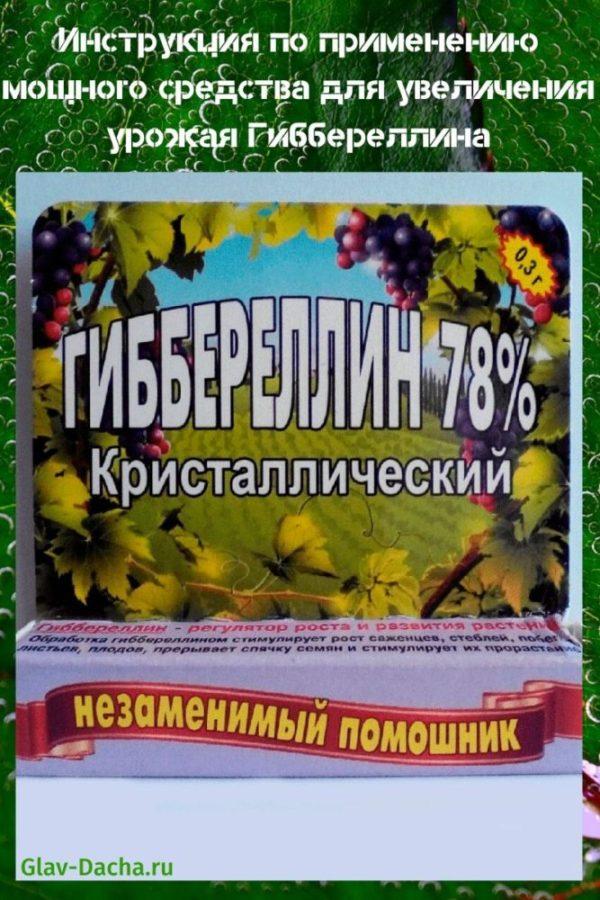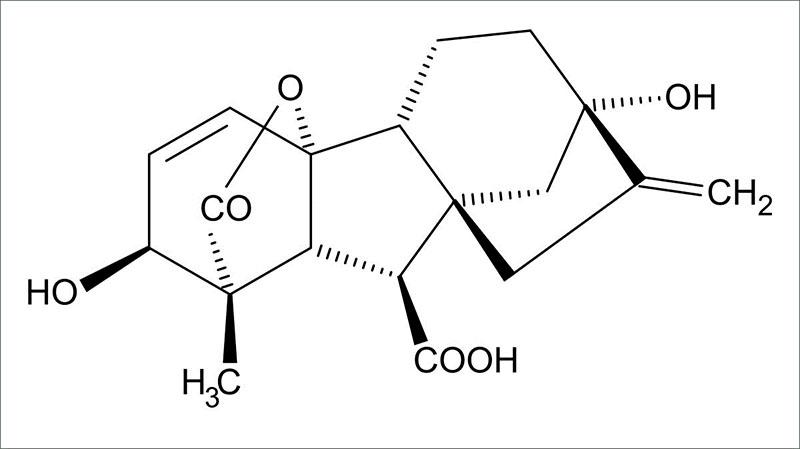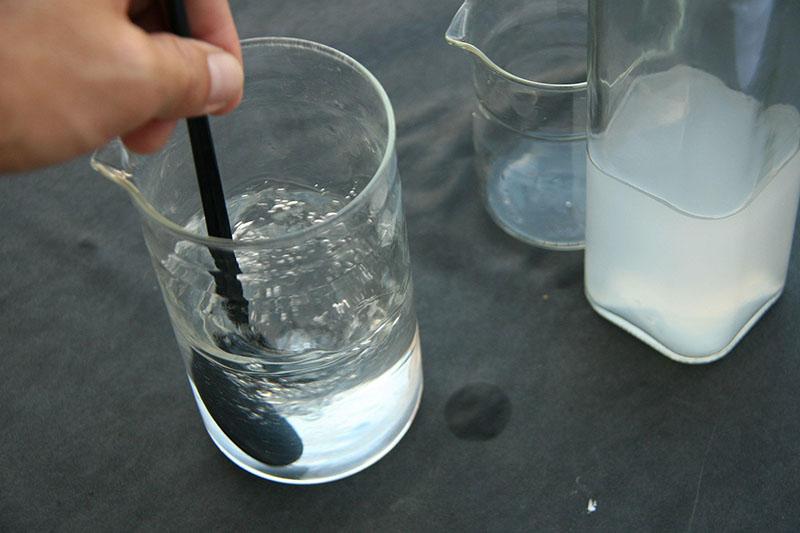Instructions for the use of a powerful agent for increasing the Gibberellin yield
 To maximize the benefits of the grown crop, gardeners, whenever possible, replace pesticides with eco-friendly preparations for plant protection and support, their list includes an extensive group of phytohormones. The most famous among them are auxins and gibberellin, the instructions for the use of which require careful study. The drug is quite capricious in work and loves accuracy. Otherwise, the grower can waste time or even damage precious plantings.
To maximize the benefits of the grown crop, gardeners, whenever possible, replace pesticides with eco-friendly preparations for plant protection and support, their list includes an extensive group of phytohormones. The most famous among them are auxins and gibberellin, the instructions for the use of which require careful study. The drug is quite capricious in work and loves accuracy. Otherwise, the grower can waste time or even damage precious plantings.
How gibberellins work

Growth stimulant gibberellin is found in fast-growing plant tissues - seedlings, unfolding leaves, immature fruits and seeds. This substance is extremely unstable and degrades quickly in alkaline or acidic environments.
Gibberellic acids play an important role in plant development. They stimulate:
- germination rate of seeds, tubers and bulbs;
- the beginning of flowering;
- lengthening of shoots and increasing plant height;
- increased productivity.
Also, gibberellins help to increase the protective forces in adverse conditions, improve the keeping quality of fruits and prolong the "youth" of plants.
According to scientists, the use of these phytohormones leads to an increase in yield from 15–20 and up to 100%, depending on the crop.
It is important that stimulant treatments do not deplete the plant, since the influx of gibberellins into the inflorescences causes their outflow from the leaves, thereby improving photosynthesis.
Preparation of the working mixture
 Instructions for the use of gibberellin require the use of an absolutely homogeneous solution of weak concentration, so the drug is first dissolved in alcohol, and then the resulting liquid is diluted with water to the required volume.
Instructions for the use of gibberellin require the use of an absolutely homogeneous solution of weak concentration, so the drug is first dissolved in alcohol, and then the resulting liquid is diluted with water to the required volume.
Very soft water is suitable - snow, rain, boiled and filtered tap water. Do not use water softeners!
Alcohol is taken in 96% ethyl or sulfated technical. The required volume is calculated as follows:
- If the weight of the drug is indicated on the package in milligrams, then the required number is divided by 10. For example, a pack of 200 mg will require 20 ml of alcohol;
- If the weight is indicated in grams, then the required volume is multiplied by 100, that is, 5 g of the drug is diluted in 500 ml of alcohol;
- Growth stimulants, available in tablets, are diluted following the instructions for use of gibberellin that are included with each package.
The latter include popular among gardeners preparations "Bud", "Ovary", "Gibberross", "Blossom".
An open pack cannot be stored, it must be diluted with alcohol immediately. The finished stock solution in a cool, dark place does not lose its properties for up to six months.
Gibberellin: instructions for use
 The table shows the amount of finished alcohol solution per liter of water at room temperature. It is poured into a bucket or other suitable clean container and the diluted preparation is added while stirring continuously.The solution is used immediately after preparation. Treatments at ambient temperatures between 18 and 27 ° C will be most beneficial.
The table shows the amount of finished alcohol solution per liter of water at room temperature. It is poured into a bucket or other suitable clean container and the diluted preparation is added while stirring continuously.The solution is used immediately after preparation. Treatments at ambient temperatures between 18 and 27 ° C will be most beneficial.
One of the prerequisites for the use of gibberellins is the impeccable care of plants - feeding, watering, compliance with the requirements of agricultural technology for lighting, soil composition, planting schemes and others.
Features of processing different types of plants
Almost all agricultural crops respond positively to spraying with phytohormones, but experience has shown that an increase in yield does not always lead to an improvement in the taste of products. For example, berries of wine and cognac varieties, treated with the drug, will be sweet and tasty, but drinks based on them will be too sour. Therefore, before using gibberellin, you should study the experience gained by other gardeners in the area for a particular variety.
Subtleties of processing grapes
 Excellent results are obtained by processing gibberellins of seedless grape varieties. It is carried out twice a season - during flowering and two weeks after the end. Later treatments can lead to the fact that massive clusters with large berries do not have time to gain sufficient sweetness. In the instructions for the use of gibberellin on grapes, the need to comply with the terms is mentioned separately.
Excellent results are obtained by processing gibberellins of seedless grape varieties. It is carried out twice a season - during flowering and two weeks after the end. Later treatments can lead to the fact that massive clusters with large berries do not have time to gain sufficient sweetness. In the instructions for the use of gibberellin on grapes, the need to comply with the terms is mentioned separately.
Three processing methods are practiced:
- Dip the brushes in a container with a working solution of a suitable size.
- The bushes are sprayed with a hand spray gun or mechanized.
- A hormonal patch is applied to the comb.
The latter method was developed by the scientist M.K. Manankov and has many advantages. Its essence lies in the fact that a plaster soaked in a preparation mixed with glucose is applied to the lower part of the vine. Thus, hormones enter the tissues continuously and the effect of uneven application during spraying is eliminated.
The effect of phytohormones on strawberries
 The instructions for using gibberellin on strawberries remind you of the need to ensure good berry care. Only in this case will the benefits of treatments be tangible. With a lack of nutrition, the berries will become smaller and lose much in taste to the control samples.
The instructions for using gibberellin on strawberries remind you of the need to ensure good berry care. Only in this case will the benefits of treatments be tangible. With a lack of nutrition, the berries will become smaller and lose much in taste to the control samples.
When using gibberellin on strawberries, it is necessary to strictly observe the dosage of the drug and the application rates for each bush. Excessively high doses of phytohormone lead to overgrowth of peduncles, prolonged growth of peduncles and deformation of berries.
The first spraying is carried out approximately 2 weeks before the differentiation of flower buds. The drug promotes lengthening of the peduncle, better growth and development of flower buds. Subsequently, the plantation is treated every 7 days. These measures allow to achieve an increase in yield up to 20% and to extend the fruiting period in time.
Gibberellin - instructions for use on tomatoes

The use of gibberellin on tomatoes is justified in the following cases:
- increased germination of stale seeds;
- flowering formation when it is delayed;
- preventing ovaries from dropping and pulling seedlings in adverse weather periods;
- extension of the growing season of varieties with a friendly return of the harvest.
Tomato seedlings are sprayed 10 days before planting in a permanent place, then twice as flower brushes appear.
The convenience of the drug lies in the fact that it can be used in tank mixes, combined with fertilizers or other biostimulants. The working solution is prepared in a separate container, then added to other pesticides.
How does the drug work on flowers
 Applying gibberellic acid to flowers requires care and attention. For treatments, you should choose a technically pure GK3, which is sold in specialized flower shops. The package must indicate the content of the active substance at least 90%.
Applying gibberellic acid to flowers requires care and attention. For treatments, you should choose a technically pure GK3, which is sold in specialized flower shops. The package must indicate the content of the active substance at least 90%.
Phytohormones have a positive effect on all flowers, but a special effect is noticeable on long-day plants that form a basal rosette and a relatively high peduncle, as well as tuberous and bulbous ones. Spraying with the drug will benefit primroses, geraniums, begonias, amaryllis, forcing tulips, hyacinths, lilies, calla lilies, muscari, chionodox and others.
Gibberellin inhibits the flowering of tropical crops, plants with a poorly expressed life cycle. In long-stemmed plants, it causes yellowing of the lower leaves.
Therefore, the use of stimulants is not suitable for all colors. First of all, it is justified for compact rosette plants that produce peduncles, and for forcing crops. The latter, after flowering, turn out to be practically unviable and, as a rule, are thrown away.
Phytohormones can bring considerable benefits - significantly increase the yield, quality and keeping quality of products. It is also important that the product is absolutely harmless to both humans and the environment. It is inexpensive and can be stored for a long time in suitable conditions. But it should be remembered that all the advantages are fully revealed only with careful observation of the instructions for the use of gibberellins.